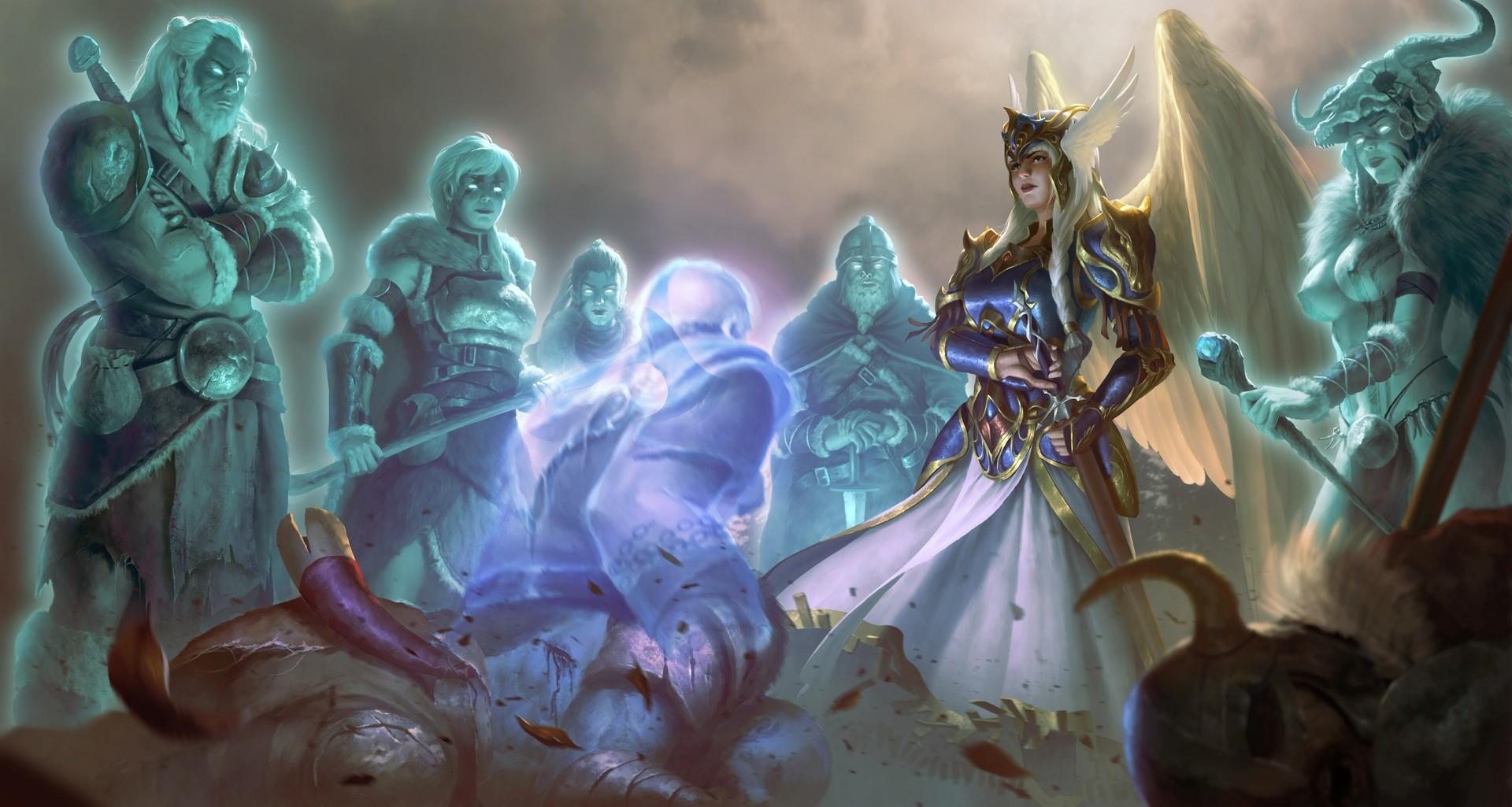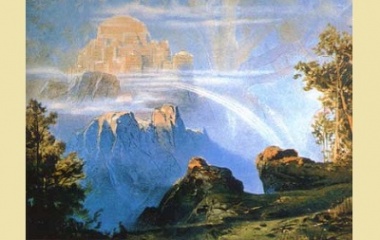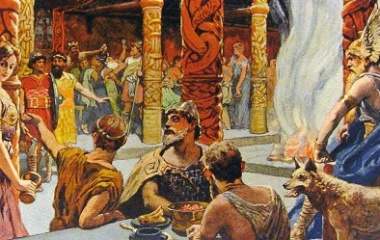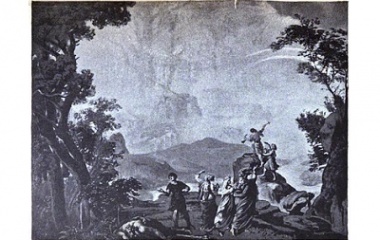In the splendid halls of the fallen there is a ceiling made of golden shields and the tables with chairs made of breast plates and armor. Every night after a day of battle and valorous deeds, the noble einherjar file into the hall and engage in a night of rich celebration. But their joyous feasting will not last forever. They wait for the day when the Midgard Serpent lets loose his tail and Odin calls upon them to fight in the last battle on earth – Ragnarök.
What is Valhalla?
Valhalla is a place of eternal glory where the most noble of the fallen warriors reside with Odin. It is said that only the most brave and talented are selected to live in this lavish paradise. Valhalla is known to be a land where there is bountiful food and drink, especially mead and meat – a warrior’s favorite indulgence. Everything in Valhalla is made to accommodate fearsome warriors in their afterlife.

How Was it Decided Who Would Be Admitted to Valhalla?
The land of Valhalla was known to be sacred and was one of the most honorable places to be admitted to in the afterlife. It was thought that there were several criteria that allowed one to enter into Valhalla and become an einherjar, but many of these are debated in modern day.
Though there is some confusion concerning the requirements to be admitted into Valhalla, it is thought that one had to die violently. For many years, it was a misconception that simply dying at the hands of another, or dying after a fight or struggle was enough to be admitted to Valhalla but the story of the death of Baldur proves that this isn’t true.
It has also been thought that one was able to enter Valhalla if they were a warrior. However, there have also been accounts of warriors who died and were unable to obtain passage into Valhalla. It is thought that this is partially because Odin has the final word when it comes to who becomes an einherjar. While there were certainly many who were admitted into this realm, there was a certain quality that had to be upheld because Odin needs these warriors to support him in a battle against Fenrir during Ragnarök.
Who Were the Einherjar?

It is known that the einherjar were the most elite warriors who died noble deaths and were thus allowed to enter Valhalla. The word, ‘einherjar’ is known to mean “fights alone” or “fighting alone.” This is likely because of the fearsome nature of these men, as well as the strength and power that they possess. This is likely also in recognition of each man’s ability to hold his own in battle – an important qualifier considering their fated battle in Ragnarök.
Did Odin Ever Influence Who Died In Battle?
It was commonly thought that Odin and the Valkyries would watch over battles and choose the outcome before the first swords were crossed. The Valkyries are thought to be beautiful female spirits that help to wait on the einherjar once they arrived in Valhalla. This is how they have come to be named ‘the choosers of the fallen.’ However, this name also has a second meaning. Mythology tells us that the Valkyries, along with Odin, would choose who would win a battle and who would die in battle before anything happened. They wove the fate of those on the battlefield together with human intestines, using heads as weights and swords as beaters.
When a battle ended, Odin and the Valkyries would take their pick of half the warriors left behind on the battlefield. These were often the most capable and elite warriors who would do well to stand beside Odin during the end times (Ragnarök). The other half of the warriors were taken by Freya.
What Does Valhalla Look Like
One of the most captivating parts of the tale of Valhalla is the sheer beauty of the paradise world that is described in the story. Valhalla is known to be an astounding hall that is situated in the realm of Asgard. This hall is known to be extremely ornate – as is the land that surrounds it.
Outside the Hall of the Fallen
Outside Valhalla there is a golden tree called Glasir – one of the most beautiful things in all of creation. In addition to this, there is a goat named Heiorun and a stag named Eikthyrnir who stand on top of Valhalla itself and graze from a tree called Laeraor. Both of these creatures help to provide the sustenance that is found in Valhalla. The goat, Heiorun, is able to produce an endless supply of the finest mead known to man. It is this mead that the einherjear of Valhalla drink every night when they celebrate the victories of the day. Eikthyrnir also drips liquid from his antlers into a spring called Hvergelmir. This spring is known to be the origin of all waters, making Eikthyrnir’s contribution equally important.
There is also a boar by the name of Saehrimnir who is used to feed the many einherjar who inhabit Valhalla. This animal is unique in that it is extremely large – it can feed well over 800 warriors with no issue – and is able to regenerate itself. It is roasted every day and used to feed the einherjar, but before the night is over it has been made whole again.
Inside Valhalla
Entering Valhalla is even more impressive than simply viewing from the side of the gates. This is the place where Odin resides along with all his fallen warriors and Valkyries. The fortress is enormous and stands at an impressive height. The roof is made of gold-bright shields that shine in the sun. When looking up, one can see the rafter made of spears high above the floor.
When entering Valhalla, it is possible to see many different sights at once. There are, of course, living areas where the warriors rest, but there are also game areas and fighting arenas. In the main hall, there are three thrones where those who preside over Valhalla sit. The lowest throne is taken by ‘High’, the middle height throne is taken by ‘Just as High’, and the tallest throne is taken by ‘Third.’ Although Third sits in the highest throne, High is actually the king of the hall.

There are also many Valkyries in Valhalla. It is their job to serve the warriors that they helped to bring to the hall and assist them with their needs in preparation for Ragnarök. The dining hall has many tables and the chairs are made from the fine breast plates and other armor. Additionally, it has been noted in some sources that bright and shining swords are used to give off light while the einherjar eat and drink. There are also many attractive shields that serve as wall panels. It is assumed that these shields are noticeably different from the shields that serve as the roof.
It is also noted that there are many rooms that make up Valhalla. Thor’s hall inside Valhalla is called Bilskirnir and has 540 different rooms! Of all the halls inside Valhalla, Odin says that this hall might be the greatest. It is thought that the space is so large that 800 men can exit through the doors of Bilskirnir simultaneously.
A Typical Day in Valhalla
One of the most interesting aspects of Valhalla is the constant state of war that surrounds it. The hall is known to be filled with the finest and most fearsome warriors that Odin can find. Therefore, it only makes sense that these warriors maintain a fierce atmosphere to keep their skills honed in preparation for the great battle of Ragnarök.

During a typical day in Valhalla, Odin sends Huginn and Muninn (his ravens) around the world and the warriors begin the day by fighting. Odin’s ravens always return before the first meal, and it is possible that their arrival signals the time for the meal to begin. It is also noted that there is time for the einherjar to play games (likely sporting games like running, jumping, etc.” and fight over the course of a day. It is most common, however, to find the spirits of the fallen engaging in combat.
Throughout the day, they fight each other and perform noble and admirable deeds. They sustain wounds just as they did in their human lives, which allows for the fighting games to hold a level of intensity that keeps their reflexes sharp. At the end of these games, however, when meal time is called, all of these wounds are magically healed.
The einherjar are then able to ride back to Valhalla and await a meal that would have been impressive even to the kings and royalty of that time period. They were served meat from the boar named Saehirmnir and were given mead that was taken from the udders of Heiorun. They are served by the Valkyries and celebrate throughout the night.
Interestingly enough, however, Odin doesn’t eat anything. This is supposedly because he doesn’t need to consume any sustenance. He does, however, drink wine. It is said that he gives his portion of meat to the wolves that accompany him – Geri and Freki. At the end of the night Saehirmnir is resurrected and the einherjar rest in preparation for the next day.
Viking Practices That Were Associated with Valhalla
Because it was such an honor to be admitted into Valhalla by Odin, it should come as no surprise that there were many aspects of Viking life that made allusions to safe passage into the warrior paradise. These practices ranged from battle traditions to burial rites.
Sacrificing Enemies
Although it was known that Odin and the Valkyries decided the fate of those on the battlefield well before the fighting actually began, it didn’t stop the Vikings from trying to sway Odin’s favor to their side in the midst of war. It was common to give human sacrifices to Odin – especially enemy royalty, nobles, and armies. These sacrifices were commonly made with spears and nooses because these are the ways in which Odin ‘sacrificed himself to himself’ in order to be granted knowledge of the runes.
One of the most common ways to secure favor with Odin during battle was thought to be to throw a spear over one’s enemies during battle and ‘sacrifice’ them by crying out. “Odin owns ye all!”
Battle Magic and the Ulfehonar
One of the most fearsome groups of warriors – the Ulfeonar (wolf warriors) were known to have pledged allegiance to Odin and were thought to make up many of the warriors who were admitted into Valhalla. They were known to live in the fringes of society and keep to themselves apart from the rest of the world. They were part of an elite shamanic group that was known to embrace the spirit of animals – a practice that was especially fearful during battle. There were also similar shamanic warrior groups called the Berserkers (bear warriors) and the Svinfylking (boar warriors).
These warriors were known to be so fearsome that fire and metal could not harm them when they were in the midst of war. In fact, they were known to intimidate their enemies by swallowing fire and eating the edges of their shields (made of iron) before entering the battlefield. They were so fierce that the other Viking warriors had to stay out of their paths when they were fighting – a member of the Ulfheonar was unable to differentiate from friends and foes while fighting. They simply killed whoever crossed their paths.
It is thought that their great successes were often granted to them by Odin when they were able to transcend their human existence and fully embrace their animal nature. Though they were greatly feared, they were also respected for this reason. It goes without saying that a high ranking Ulfheonar who had successfully left humanity behind was automatically assumed to have been granted passage into Valhalla when they died in battle.
Burial Rites
It was known in Norse societies that all of the warriors (and many other dead) were thought to be burned on a funeral pyre on top of a burial mound with all of their possessions. It was thought that this practice would help them cross over to the afterlife to meet with Odin in Valhalla. It also allowed them to take all of their possessions with them to the next life – most notably their favorite weapons.
Their ashes were then sent to sea or buried in the ground so that they would have safe passage. Their possessions were also sometimes ‘hidden’ in the ground so that they could claim them once they arrived in Valhalla. Once these rites had been accomplished, they would be able to enjoy their time in Valhalla with all of their favorite weapons and memories from their life on Earth.
Myths Surrounding Valhalla
There are many verses that concern Valhalla and its heroes. As one of the most respected places known to the Norse culture, there are many stories that tell of the structure and the people who live there. These are a few of the more popular myths that have come to be told about Valhalla.
Helgi Hundigsbane Enters Valhalla
Helgi is known to be a respected hero in Norse mythology and made his name by killing his father’s enemy, King Hunding, at only 15 years of age. This is how he earned the name ‘Hundingsbane.’ After killing the king, Helgi continues to do acts of valor and eventually attracts the attention of a Valkyrie named Sigrun who came to him while he was sailing on his longship. He immediately fell in love and pursued her hand in marriage.
She was betrothed to another, however, and Helgi first had to battle her father and fiancé to secure her hand in marriage. When this is finished, only one of her brothers – Dag – survives. Helgi and Sigrun live happily for a time, but when Dag is overcome with grief and kills Helgi to uphold his family’s honor, Helgi’s spirit is taken to Valhalla.
While in Valhalla, Helgi is asked to help Odin manage Valhalla because of his impressive accomplishments on Midgard. Helgi spends time torturing his old nemesis, Hunding, for a time by making him do menial chores. However, he is somehow allowed to return to Midgard for one day. He uses this time to reconnect with his Valkyrie wife, Sigrun. Before the sun rises, he returns to Valhalla and never again returns to Midgard. Sigrun eventually died of sadness. There are those, however, who believe both Helgi Hundingsbane and Sigrun were reborn as the hero Helgi Haddingjaskati and the valkyrie Kara.
King Gylfi Searches for the Power of the Gods in Valhalla
There is a legend of a King named Gylfi who travels to Asgard in search for the power of the gods. He uses the name Gangleri to hide his true identity and attempt to complete this daunting task. King Gylfi was the first king of Scandinavia and was known to have used the name Gangleri when trying to hide his identity on many occasions.
As the story goes, King Gylfi thinks he will be able to sneak into Asgard without anyone knowing who he was, but the gods foresaw his arrival and made the realm appear even more grand than it was in actuality. This, in part, is why he focuses on Valhalla so much. The prose that records this adventure contains much of the information that is used to describe Valhalla in modern day.
When Gylfi enters Asgard, he sees a hall so large that he cannot see over it. This hall has a roof that is covered with golden shields in place of shingles and men that perform seemingly impossible feats. When he walks closer, he sees a man who juggles 7 different short swords at the same time. The man explains that the king who rules the hall is inside and offers to give Gylfi a tour. As they walk he sees the impressive size of the building, the men who are playing games and fighting each other, and the many tables where more men are gathered to drink together. Eventually they reach the throne room and he meet three men seated on thrones.
Gylfi eventually learns that High is the king of the hall and that the hall is full of spirits of the warriors that have fallen in battle. It is also discovered that Odin is the one responsible for the hall and the selection of warriors who inhabit it. We also learn that although there are many warriors, their eating and drinking needs are always taken care of thanks to the animals who live in the hall. One of the last things that is discovered is the daily routine of the einherjar and the unfortunate death of the god Baldr.
Hrungnir Fights Thor
There is also an account of a jötunn named Hrungnir. In Norse mythology, a jötunn is an entity that is not human but is something other than a god. chases Odin in anger and ends up following him to Valhalla. The gods invite him in to drink with them and he accepts. Soon, however, he becomes drunk and begins bragging about his intentions to take Valhalla back to the land of the jötunn. The gods are quickly annoyed by this and they call upon Thor to take care of Hrungnir.
Thor arrives and challenges Hrungnir to fight, but Hrungnir realizes that Valhalla has the power to regenerate a warrior if willed by the gods who rule there. Because of this, he accepts the challenge but states that the fight must take place outside of Valhalla in Griotunagardar. The two travel to Griotunagardar and fight against each other in a gruesome battle and Hrungnir is eventually killed by Thor.
Origin of the Myth
As is the case with many mythical places in the afterlife, Valhalla was likely created as a comforting idea for what would happen to the brave warriors who didn’t return from battle. Valhalla was a way for the Norse people to deal with their grief, knowing that their loved ones had died with honor and were in a better place.









